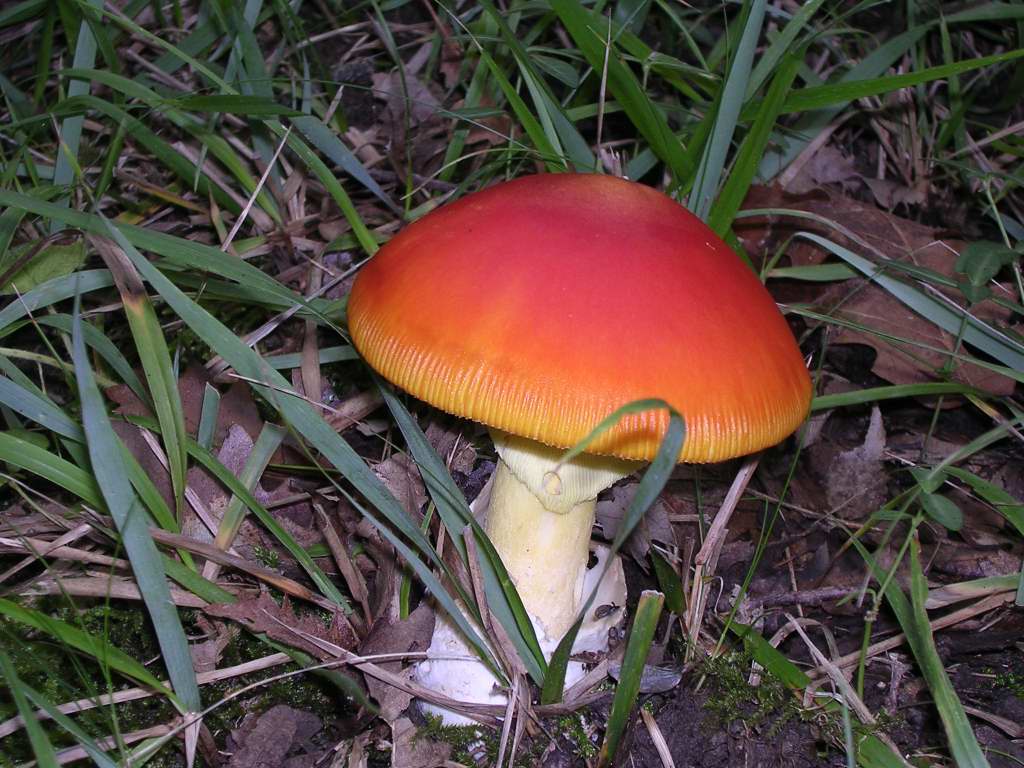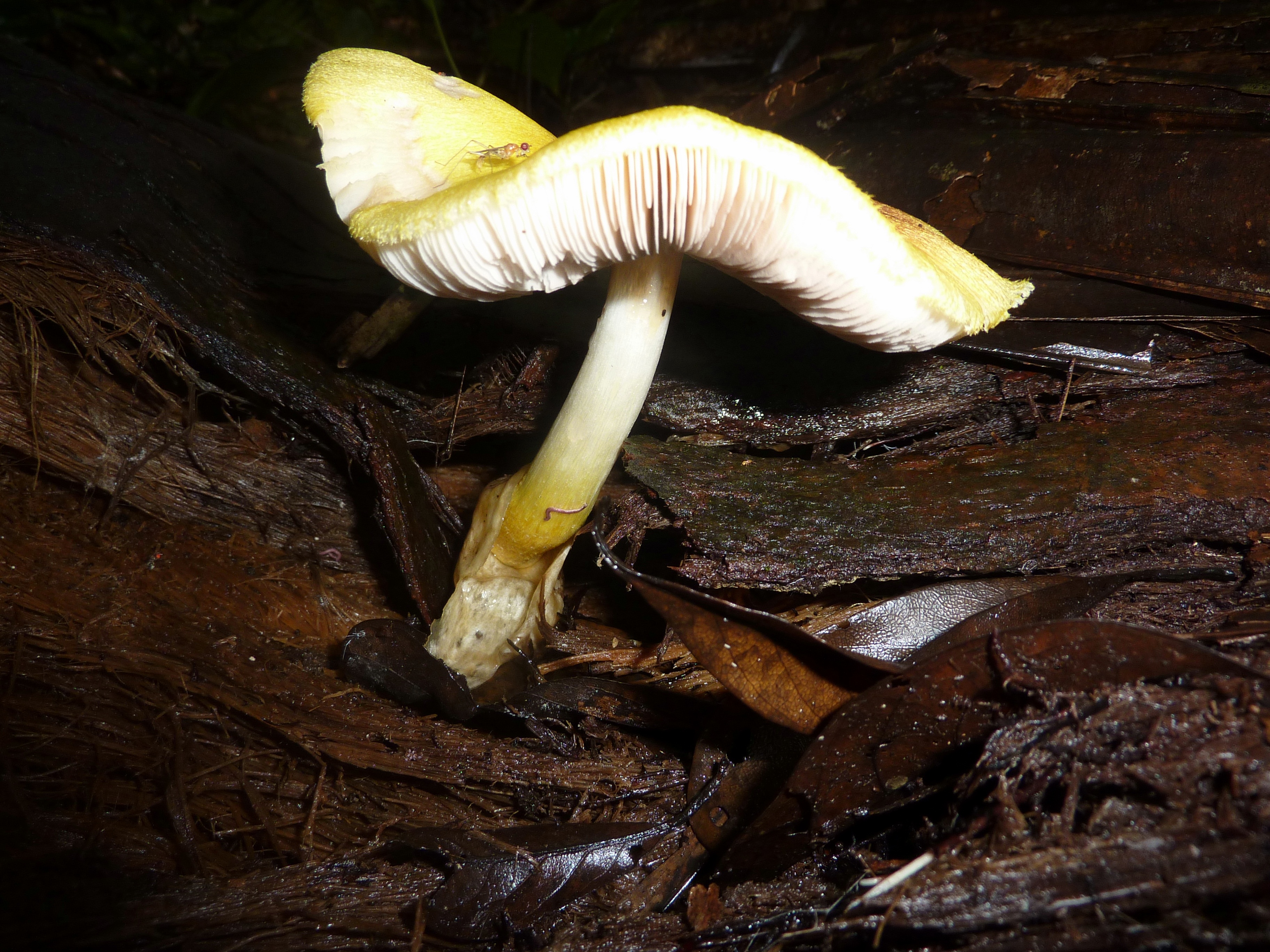|
Volva (mycology)
In mycology, a volva is a cup-like structure at the base of a mushroom that is a remnant of the universal veil, or the remains of the peridium that encloses the immature fruit bodies of gasteroid fungi. This macrofeature is important in wild mushroom identification because it is an easily observed, taxonomically significant feature that frequently signifies a member of Amanitaceae. This has particular importance due to the disproportionately high number of deadly poisonous species contained within that family. A mushroom's volva is often partially or completely buried in the ground, and therefore care must be taken to check for its presence when identifying mushrooms. Cutting or pulling mushrooms and attempting to identify them later without having noted this feature could be a fatal error. Whilst a volva is a feature best known from ''Amanita'' species and stinkhorns such as the Phallaceae family and others in the Phallales order, it may also occur with other genera in ... [...More Info...] [...Related Items...] OR: [Wikipedia] [Google] [Baidu] |
Amanita Caesarea
''Amanita caesarea'', commonly known as Caesar's mushroom, is a highly regarded edible mushroom in the genus ''Amanita'', native to southern Europe and North Africa. While it was first species description, described by Giovanni Antonio Scopoli in 1772, this mushroom was a known favorite of early rulers of the Roman Empire. It has a distinctive orange pileus (mycology), cap, yellow lamella (mycology), gills and stipe (mycology), stipe. Organic acids have been isolated from this species. Similar orange-capped species occur in North America and India. Although it is edible, the Caesar's mushroom is closely related to the psychoactive fly agaric, and to the deadly poisonous death cap and destroying angels. These can easily be confused for ''A. caesarea'' and thus, presumed ''A. caesarea'' specimens must be identified with complete certainty before they can be assumed edible. Taxonomy ''Amanita caesarea'' was first described by Italian mycologist Giovanni Antonio Scopol ... [...More Info...] [...Related Items...] OR: [Wikipedia] [Google] [Baidu] |
Battarrea
''Battarrea'' is a genus of mushroom-producing fungi. The genus used to be classified in the family Tulostomaceae until molecular phylogenetics revealed its affinity to the Agaricaceae. Species of ''Battarrea'' have a peridium (spore sac) that rests atop an elongated, hollow stipe with a surface that tends to become torn into fibrous scales. Inside the peridium, the gleba consists of spherical, warted spores, and a capillitium of simple or branched hyphal threads that have spiral or angular thickenings. The genus is named after Italian priest and naturalist Giovanni Antonio Battarra. Species *'' Battarrea arenicola'' Copel. (1904) *'' Battarrea franciscana'' Copel. (1904) *'' Battarrea guachiparum'' Speg. (1898) *'' Battarrea griffithsii'' Underw., Bulletin of the Torrey Botanical Club 28: 440 (1901) *'' Battarrea laciniata'' Underw. ex V.S.White (1901) *'' Battarrea levispora'' Massee (1901) *'' Battarrea patagonica'' Speg. (1898) *'' Battarrea phalloides'' (Dicks.) Pers. (1801 ... [...More Info...] [...Related Items...] OR: [Wikipedia] [Google] [Baidu] |
Volvariella Surrecta
''Volvariella surrecta'', commonly known as the piggyback rosegill, is an agaric fungus in the family Pluteaceae. ''V. surrecta'' mushrooms have white or greyish silky-hairy caps up to in diameter, and white gills that turns pink in maturity. The stipe, also white, is up to long, and has a sack-like volva at its base. Although rare, the species is widely distributed, having been reported from Eurasia, northern Africa, North America, and New Zealand. The fungus grows as a parasite on the fruit bodies of other gilled mushrooms, usually ''Clitocybe nebularis''. Taxonomy The species was first mentioned in scientific literature as ''Agaricus surrectus'' by English botanist John Leonard Knapp in his 1829 ''Journal of a Naturalist''. Knapp described the species and illustrated it in a woodcut. He wrote: We have even an agaric, with a bulbous root and downy pileus, that will spring from the smooth summit of another (agaricus caseus), which has a uniform footstalk, though ... [...More Info...] [...Related Items...] OR: [Wikipedia] [Google] [Baidu] |
Volvariella Bombycina
''Volvariella bombycina'', commonly known as the silky volvariella, silky sheath, silky rosegill, silver-silk straw mushroom, or tree mushroom, is a species of fungus in the family Pluteaceae. The basidiocarp, fruit body (mushroom) begins developing in a thin, egg-like sac. This ruptures and the stem expands quickly, leaving the sac at the base of the stem as a volva (mycology), volva. The pileus (mycology), cap, which can attain a diameter of up to , is white to slightly yellowish and covered with silky hairs. On the underside of the cap are closely spaced lamella (mycology), gills, free from attachment to the stipe (mycology), stem, and initially white before turning pink as the spores mature. It is an uncommon but widespread species, having been reported from Eurasia, Australia, North America, and the Caribbean. The mushroom grows singly or in clusters, often appearing in old knotholes and wounds in elms and maples. It is edible mushroom, edible and contains compounds with ... [...More Info...] [...Related Items...] OR: [Wikipedia] [Google] [Baidu] |
Conocybe Volviradicata
''Conocybe volviradicata'' is a species of mushroom-producing fungus in the family Bolbitiaceae. Taxonomy It was described in 2011 by the mycologists Roy Watling, Mustafa Işıloğlu and Hayrünisa Baş Sermenlı who classified it as ''Conocybe volviradicata.'' It is notable as being one of the few ''Conocybe'' species which has a volva and subsequently was placed in ''Conocybe sect. Singerella'' along with the other volvate species. Description ''Conocybe volviradicata'' is a small brown volvate mushroom. Cap: 1.5cm wide and conical to campanulate. The surface is cinnamon to sienna brown but dries to a buff or yellowish cream colour. It is smooth and silky with a striate margin. The flesh is thin and up to 1mm in the centre. Gills: Almost free, crowded and pale ochre. Stem: 3cm long and 3mm thick with a cream colour surface and distinct striations running to the start of the volva. The base of the stem has a volva and a rooting base that is up to 2cm long. Spore print: o ... [...More Info...] [...Related Items...] OR: [Wikipedia] [Google] [Baidu] |
Conocybe Volviornata
''Conocybe volviornata'' is a species of mushroom-producing fungus in the family Bolbitiaceae. Taxonomy It was described in 2002 by the Egon Horak, Anton Hausknecht and Dennis E. Desjardin who classified it as ''Conocybe volviornata.'' It is notable as being one of the few ''Conocybe'' species which has a volva and subsequently was placed in ''Conocybe sect. Singerella'' along with the other volvate species.'''' Description ''Conocybe volviornata'' is a small volvate mushroom. Cap: 1–2.5 cm wide and conical. The surface is pinkish-beige with a reddish-brown centre and a white fluffy to velvety coating from the pileicystidia. It is membranous, dry, thin and brittle and very strongly hygrophanous with the striations being visible from the margin to centre when moist. Stem: 4.5–9 cm long and 1.5-2mm thick tapering upwards slightly from a 6mm wide base. The surface is the same colour or paler than the cap with a dense covering of caulocystidia. It is fragile but ... [...More Info...] [...Related Items...] OR: [Wikipedia] [Google] [Baidu] |
Conocybe Volvata
''Conocybe volvata'' is a species of mushroom-producing fungus in the family Bolbitiaceae. Taxonomy It was described in 2001 by the K. Agregtitous Thomas, Anton Hausknecht and P. Manimohan who classified it as ''Conocybe volvata.'' It is notable as being one of the few ''Conocybe'' species which has a volva and subsequently was placed in ''Conocybe sect. Singerella'' along with the other volvate species.'''' Description ''Conocybe volvata'' is a small brown volvate mushroom. Cap: 1.5-5.5 cm wide and campanulate, conical or conico-convex sometimes with an obtuse umbo. The surface is brown and may be concolorous all over or present with reddish brown colouration towards the centre disc and light brown colours towards the margin. It is hygrophanous and becomes greyish orange as the moisture content changes. The surface is smooth with fine striations visible when moist and the flesh is brownish white and up to 1.5mm thick at the centre. Gills: Adnexed to adnate, light b ... [...More Info...] [...Related Items...] OR: [Wikipedia] [Google] [Baidu] |
Conocybe Vaginata
''Conocybe vaginata'' is a species of mushroom-producing fungus in the family Bolbitiaceae. Taxonomy It was described in 1979 by the Scottish mycologist Roy Watling who classified it as ''Conocybe vaginata.'' It is notable as being one of the few ''Conocybe'' species which has a volva and subsequently was placed in ''Conocybe sect. Singerella'' along with the other volvate species. Description ''Conocybe vaginata'' is a small volvate mushroom. Cap: 1.4-2cm wide starting hemispherical to ovoid to campanulate before expanding with age. The hygrophanous surface is smooth, dry and very striated with a brownish or greyish beige colour. Stem: 7-7.6cm long and 1-2mm thick. The surface is white and smooth with a pubescent coating all over but no striations. It is very fragile and hollow with a swollen base that sits inside the persistent, membranous white volva. Gills: Free to adnexed, greyish beige to pale rust coloured becoming more rust brown with age. They are narrow and vent ... [...More Info...] [...Related Items...] OR: [Wikipedia] [Google] [Baidu] |
Conocybe Locellina
''Conocybe'' is a genus of mushrooms with ''Conocybe tenera'' as the type species and at least 243 other species. There are at least 50 different species in North America. Most have a long, thin fragile stipe and are delicate, growing in grasslands on dead moss, dead grass, sand dunes, decayed wood, and dung. ''Conocybe'' species generally prefer fertile soils in lawns and pastures and are found worldwide. ''Conocybe'' species are sometimes called dunce caps or cone heads due to their conical or bell-shaped caps. Former species of ''Conocybe'' that have a well-developed partial veil and/or lack lecythiform cheilocystidia have been transferred to the genus ''Pholiotina'', which was formerly a subgenus of ''Conocybe''. However, ''Pholiotina'' as it is currently defined is polyphyletic, although none of the three clades that make it up belong in ''Conocybe''. Similar to ''Galerina'', a ''Conocybe'' species can be distinguished microscopically by its cellular cap cuticle, which is ... [...More Info...] [...Related Items...] OR: [Wikipedia] [Google] [Baidu] |
Conocybe Corneri
''Conocybe corneri'' is a species of mushroom-producing fungus in the family Bolbitiaceae. Taxonomy It was described in 1979 by the Scottish mycologist Roy Watling who classified it as ''Conocybe corneri.'' It is notable as being one of the few ''Conocybe'' species which has a volva and subsequently was placed in ''Conocybe sect. Singerella'' along with the other volvate species. Description ''Conocybe corneri'' is a small volvate mushroom. Cap: 2-6cm wide and 1.5-2.5cm high starting conical then umbonate before flattening with age. The surface is dark purple with fine striations when young but it becomes wine red or reddish grey as it ages. It is hygrophanous and smooth with finely pubescent white hairs. The flesh is 1-1.5mm thick in the centre of the cap and is concolorous with the exterior surface. Stem: 10-16cm long and 2-3mm thick tapering upwards from a 5-7mm base. The surface is covered in fine pubescent hairs with spiraling striations up its length and is white to ... [...More Info...] [...Related Items...] OR: [Wikipedia] [Google] [Baidu] |
Conocybe Anthuriae
''Conocybe anthuriae'' is a species of mushroom-producing fungus in the family Bolbitiaceae. Taxonomy It was described in 1997 by the Scottish mycologist Roy Watling and the Austrian mycologist Anton Hausknecht who classified it as ''Conocybe anthuriae.'' It is notable as being one of the few ''Conocybe'' species which has a volva and subsequently was placed in ''Conocybe sect. Singerella'' along with the other volvate species.'''' Description ''Conocybe anthuriae'' is a small brown volvate mushroom. Cap: 0.6-1.5cm wide and up to 1cm high starting campanulate to convex and not expanding much with age. The surface is hygrophanous and brown but becomes paler or dirty yellow-orange in the centre with a yellowish white colour at the cap margins. It is smooth and lacking in striations when young but is radially sulcate when older with a pubescent coating when dry. Gills: Adnate, distant and pale cream coloured becoming pale yellowish brown with age. Slightly ventricose. Stem ... [...More Info...] [...Related Items...] OR: [Wikipedia] [Google] [Baidu] |


